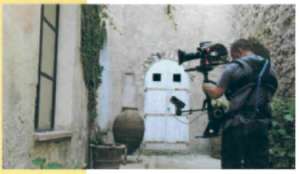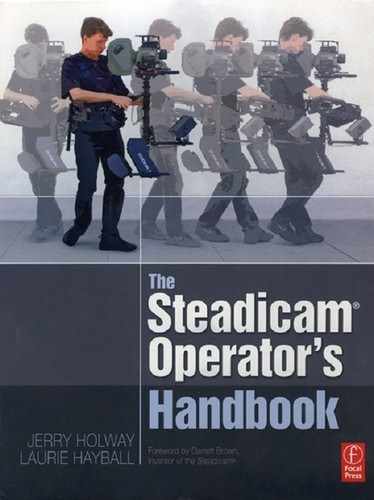Your role as storyteller
play the part
As strange as this may sound, as a Steadicam operator, you are playing a kind of pan in the film. In every frame, a choice is made: what to include and what to leave out of the shot. Each time you make a framing choice, you are determining how the story is told.
The camera is moving, now you have more choices to make. How does the camera move through space? Is it slow and methodical? Is it quick and full of energy? Are the pans rapid or slow?
Let's examine one scene shot two different ways:
The script says, “Two boys are playing. One of them, Julio, notices something off screen. He stops playing, goes into the house, and gets a gun off the kitchen table.” Dull script.

Version #1
The director says to you. “Basically, the camera starts outside on the boys playing. Julio turns and moves toward the house. The camera follows him as he goes inside where he finds a gun on the table and picks it up. It starts pretty wide: here's the frame (as he hands you the director's finder). This is exactly what I want. After Julio's look off screen, I want you to precede him in a raking shot to the house. Inside, the camera moves in and watches Julio pick up the gun in a tight shot of the gun “ Again he hands you the finder and shows you the frame. This director has said a lot, but you still have questions.
Outside: Is there a push in or out, any camera movement before Julio notices something off screen? Does the camera respond in any way to his look off-screen, or just on his movement? What is the height of the camera during the move?
The move: Is the move fast? Should the camera precede him through the door? You offer the idea that preceding would help the shot — less ground to cover at the end of the shot, and it emphasizes the character. The director says, “No, I need to follow Julio and only catch his face after he picks up the gun. From over here ” Hmmm, a new end mark.
More questions on the final frames: Do we tilt up from CU gun to see Julio's face after he picks up the gun, or do we pull slowly back to reveal Julio's look? How exactly does the shot end? Does Julio exit frame? Are we still moving?
Subtext: Does the audience already know (revealed earlier in the story) what Julio sees off screen? Is this part of the story suspenseful or simple action? The answer here will help you to pace yourself and determine a mood for the move.
Version # 2
Same dull script, but the director says to you. “The camera starts outside on the boys playing. As they continue to play, the camera pans away to the house. It slowly moves through the door and pushes in on a gun lying on the table A hand enters the frame and grabs the gun. Here's the sho. “With a video viewfinder this time, he shows you the shot he has recorded with the assistant director on a scout several weeks earlier.

Clearly, we're telling a very different story in this version, and the whole visual plan is laid out for you. But you still need to ask questions.
Outside: What angle, height, and distance is the camera from the boys? Is the pre-visualization accurate; is that the camera height he really wants? “Well, I don't know, perhaps it's better a bit lower, like this.” At what point does the camera pan off Is there some action on which to start the move? “No, I'll cue you.”
Is the shot someone's POV or is the camera playing the role of an omniscient storyteller? This is a much more difficult shot than the first example because the camera takes on a consciousness. The operator must play a role key to revealing the story. The moment the camera pans off the principal action, the audience's interest is piqued. They want to know why. Where is the camera going to take us? Therefore, the strength of the move will either make or break this moment in the film. You ask for a countdown cue — three, two, one, move.
The move: Is it quick or methodical? Should it feel connected to the ground like a person? Or should it float like a spirit toward the house? Once inside, does the camera go straight for the gun on the table, or does it look around the room first? Should the shot be a high angle of the gun, or from eye level? Whose eye level? When do we shift from the low level outside to the higher level inside?
The final frame: Does the shot end as the hands come into frame and grab the gun? Does the gun leave frame? Does the camera ever reveal who picks up the gun? Subtext: What's really going on in this shot? Has this omniscient presence been here throughout the movie?
The same action can be presented in different ways, creating very different reactions from the audience. Therefore, you must ask very specific questions that clearly define the camera's path, speed and intent. Be familiar with the story and understand the style of storytelling. Know the role you are playing. Are you a specific character (POV shot)? Are you an omniscient (all-knowing, all-seeing) force that is revealing the story to the audience through unmotivated moves and foreshadowing? Are you simply a witness to the action, learning the story along with the audience?
The shot musstbelear in your head
If you haven't made any of these decisions before you start the shot, then you will be forced to simply react to the action. Consider the shot described above. You have a frame of the boys in front of the house. Julio looks offscreen. If you haven't made a plan, you might be inclined to pan off Julio to discover what he is looking at. Meanwhile, Julio has staned his move to the house. You pan the camera back and in your urgency not to get too far behind, you push quickly toward him. You follow him through the door, but haven't made a plan about how to reveal the gun. You linger on the CU of the back of Julio's head too long, and are forced into an awkward tilt down to see the gun on the table. What a mess!
What story did this shot tell? This kind of shot calls attention to the camera. If you are unsure about what to have in the frame, the audience is not going to be clear on what is hap-pening in the story.

You must decide how to reveal the information, what to show the audience, and in what order You might leave something out of frame because you want to surprise the audience with it later. You are the visual storyteller. Each decision creates a meaning and supports an emotion.

For example, the camera peers through a window, spying on the people inside. If the camera simply shoots through the glass panes without moving, there is nothing that tells the audience why we are staring through the window. However, if the camera starts with the wall in frame and then slowly, care-fully slides to where it (and we) can see inside, then we are drawn into the scene thinking someone is looking through the window. If the camera pulls back as if hiding upon a look from one of the character, inside then from one of the characters inside,thenwe infer tha whoever it is looking inothrough the window doesn't want to be seen.
Your shot could be 10 seconds or 10 minutes. Before you can successfully operate that shot, you must be completely comfortable and familiar with every moment in the shot. Hence, the longer the shot, the more effort; but even with a short shot you must take it all on. Your focus should be extreme, driving through every frame of film.
Forget about the physical space and effort you are making to get the shot, and focus simply through the camera, flying the lens through the scene in a way that reveals the story to the audience.
